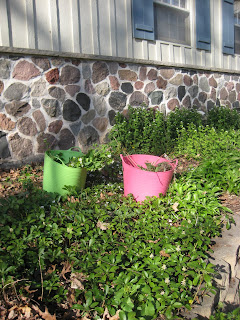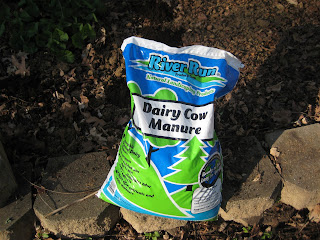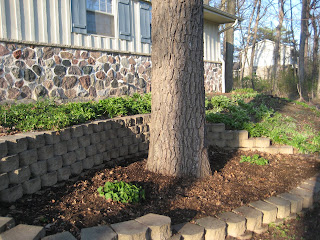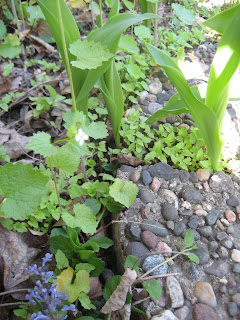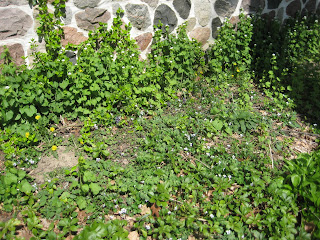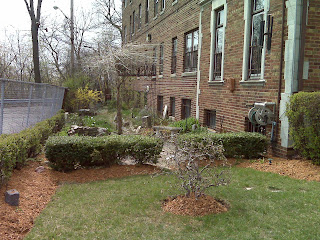Tag: Gardening in Wisconsin
Making progress
April 20, 2010
Still not time to plant, but there’s plenty to do in the meantime. Trying to work my way around the house cleaning up the existing beds. All of which appear to have been ignored for years.
This weekend I decided to focus on cleaning up the south side of the house. This is the sloped area with the retaining wall and planted primarily in hostas with a touch of pachysandra, lamium and lily of the valley. In summer this area is in full shade.
As of Friday it was also full of Garlic Mustard. Inspiring me to do some research and even write a post about it. Spent most of Saturday attacking the weeds.
 After clearing the weeds, I wanted to amend the soil a bit to prep for planting. There was already a nice coating of chopped partially composted leaves, so added a couple of 50# bags of alfalfa pellets (one of my very special secret garden ingredients), and a few bags of cow manure, and tilled it all up. Ok, I admit, I just wanted to play with some power tools, but the bed needed the work!
After clearing the weeds, I wanted to amend the soil a bit to prep for planting. There was already a nice coating of chopped partially composted leaves, so added a couple of 50# bags of alfalfa pellets (one of my very special secret garden ingredients), and a few bags of cow manure, and tilled it all up. Ok, I admit, I just wanted to play with some power tools, but the bed needed the work!
Be afraid, be very afraid……
April 18, 2010
At first glance, a charming scene. Some sort of groundcover weaving its way between the Lily of the Valley. But step back a bit, look at the whole scene, and you quickly realize that is not the case.
This is our third spring since we relocated to Wisconsin, the second in this house. The first spring was spent in “corporate housing” while we searched for a house. That apartment backed up to the fox river plain. During that spring I marveled at the wild turkey that wandered onto our patio, the occasional sighting of a fox, and wondered about the plant with white flowers that seemed to be taking over the landscape.
Garlic Mustard (Alliaria petiolata), at first glance such an innocent looking plant. Presumably introduced from Europe for culinary or medicinal properties, but one of those plants that outside of its native habitat has proven invasive, crowding out other plants. Endangering the natural habitat.
And it’s no wonder. These lines from the King County, WA noxious weeds website pretty much sum it up:
“The fact that it is self fertile means that one plant can occupy a site and produce a seed bank. Plant stands can produce more than 62,000 seeds per square meter to quickly out compete local flora, changing the structure of plant communities on the forest floor. Garlic mustard is also allelopathic, producing chemicals that inhibit the growth of other plants and mychorrizal fungi needed for healthy tree growth and tree seedling survival.”
Last year, I did my best to pull up or cut off flowers of the plants I saw around the yard, but hadn’t noticed the small seedlings. In fact, I hadn’t really studied up on the plant and assumed this was an annual. I wasn’t looking for the first year seedlings. Yesterday, as I attacked the current season crop, the long tap roots of the plant made me realize, this was no annual. This is a biennial. Meaning it grows two season – seeds sprout in the first spring, flowers in the second spring, sets seeds and dies. And this plant does all that with remarkable vigor. This robust root structure is not the result of a single spring’s growth, and explains why the WI DNR site says not to just cut off the tops in the spring. This is a plant built to survive, it can re-sprout, is built to do so.
And that’s when I noticed the seedlings. Thousands and thousands of them. Between rocks, under plants, in the walkways. EVERYWHERE.
This spring’s seedlings in the the cracks of the retaining wall will become next spring’s plants.
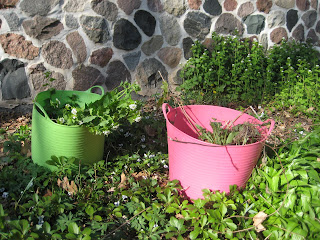
The local recycling center will not accept garlic mustard, which tells me not to compost it. This means my weeding has now become a two trug job, one for the “normal” weeds, and one for the garlic mustard. In my old Kentucky and southern Illinois gardens, I fought henbit and chickweed each spring. Thought those were the worst things to battle. Know I have a much more formidable opponent in this plant. Will have to be much more vigilant, but is it me or the garlic mustard who needs to be afraid…at least in this little patch of ground.
I spy with my little eye….
April 14, 2010
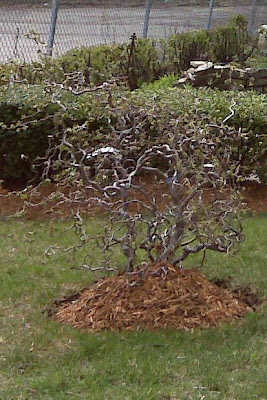 Have a new resolution to try and get out of the office for a fast-paced walk over lunch on most days. Not sure why in two years of working from this office I never did that. Is a good little habit I’m bringing back from my Chicago office days.
Have a new resolution to try and get out of the office for a fast-paced walk over lunch on most days. Not sure why in two years of working from this office I never did that. Is a good little habit I’m bringing back from my Chicago office days.
This week as I was trotting along Martin Drive, out of the corner of my eye, I spotted a pretty little Henry Lauder’s Walking stick (Corylus avellana “Contorta”). The intricacy of the twisted branches slowed my pace a bit, the plant tag and fresh mulch slowed it a bit further. But what stopped me dead in my tracks was the garden I noticed behind the bush, well, behind the low hedge behind the bush.
A charming little urban oasis. Paved seating area up front. Pretty iron arbor with some sort of climber – curious to see that that is when it leaves out. Stone path through what appears to be a herb garden. Lots of garden art, both on the wall and throughout the space. Another seating area in the back with a small statue centered at the rear. Obviously well tended. Someone or someones pride and joy. In a sliver of land between an apartment building and a parking lot. Somewhat a fringe neighborhood, abutting the semi-industrial area of Milwaukee where the Harley Davidson headquarters and Miller Brewery are located.
I’ve driven by the spot probably hundreds of times on the way to and from work. And have never noticed this garden. Now I can’t wait to watch it through the seasons. Funny what slowing down and paying attention to the world around you can bring…………….
Where to begin……
March 28, 2010
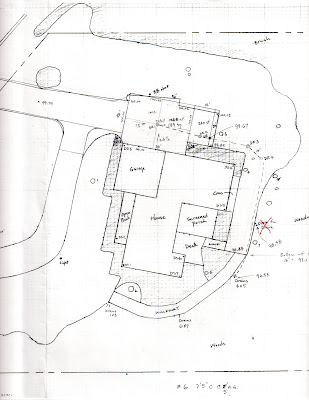 There’s plenty of evidence around my yard that someone at sometime had some professional landscaping done. In fact it appears that maybe multiple someones at multiple times – some professionally done, some not so. I found this plat drawing in the folder of appliance manuals and other household info the previous owners left behind.
There’s plenty of evidence around my yard that someone at sometime had some professional landscaping done. In fact it appears that maybe multiple someones at multiple times – some professionally done, some not so. I found this plat drawing in the folder of appliance manuals and other household info the previous owners left behind.
Problem is it is also apparent that no effort was made to making these “improvements” over time cohesive. Nor was any effort made to maintain the plantings. Which leaves me struggling in the unknown territory of a shady yard, and unlike the other gardens I’ve created – the lack of a blank slate to create as my own. Instead, I must build upon what I have – make decisions about what to keep, what to lose, and most importantly, where to start. It will be 2 years in July since we moved in, and I’ve let the garden and yard plans fall into a bit of inertia.
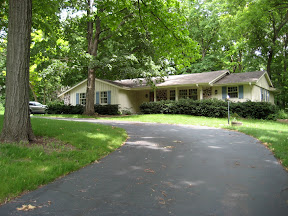
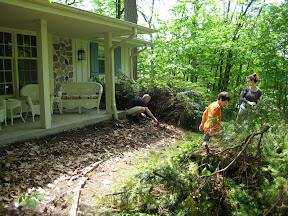 My sister in-law and brother tried to jump start me last Memorial Day with an impromptu decision to cut down what I referred to as the “damn yews” along the front of the house. While that did lead to a little plant buying spree (yes, I am a bit of a hortaholic by nature), other than several container plantings, nothing new happened in the yard.
My sister in-law and brother tried to jump start me last Memorial Day with an impromptu decision to cut down what I referred to as the “damn yews” along the front of the house. While that did lead to a little plant buying spree (yes, I am a bit of a hortaholic by nature), other than several container plantings, nothing new happened in the yard.
This year I am ready. For a variety of reasons. And frankly it’s time.
I know I will keep this original edging along most of the borders of the yard.
Problem is, most of this area has also been allowed to go wild. Lots of junk trees, rampant suckers. Not a lot to keep. But probably also not a first priority.
Instead I’ve got my eye on (read want to remove) two areas which seem to be later additions. The edging doesn’t match, the island one is out of scale, and the plants inside, just bad. Lots of common (and invasive) honeysuckle.
On the side of the house, yet another type of hardscape, probably the most recent addition based on the retaining wall material. Actually not a bad area, even if I’m not overly fond of this manufactured stacked concrete material. Most of the bed is hostas, want to do some sort of low shrub at the top, and that front lower bed is empty except for a couple of wild ginger (Asarum canadense). Figure this is where I’ll start playing with shade perennials.
But the area where I really need to focus. Where I can make the most impact. Where I have the closest to a blank slate is the front of the house. The place we cut down the damn yews. This is where I need to get out my design pencil and put on my thinking cap. Yes, astute reader, that’s yet another form of edging. Want to expand the beds, change the lines. Have ideas. Time to put those to practice.
Meanwhile, we did make a smidgen of progress on the side. Bed full of overgrown, gangly sumac (Rhus aromatica). Cut them back hard. Just going to mulch this bed this year. Hoping to get them shaped up, at least presentable for this year. Know they will be replaced. But not this year. Because I think I’m beginning to see the starting point. Should be an interesting journey. Come with me, ok?
